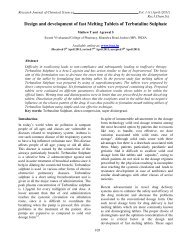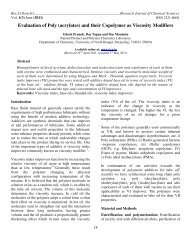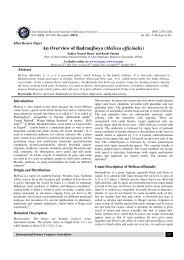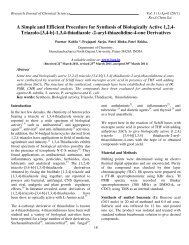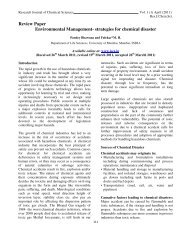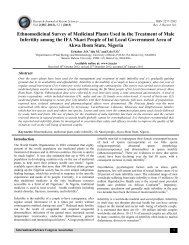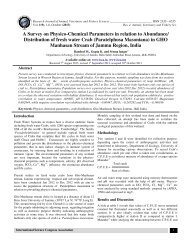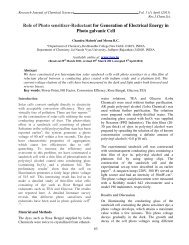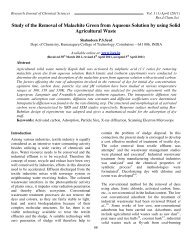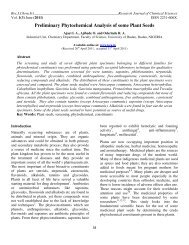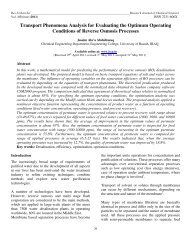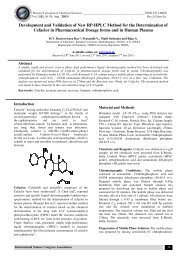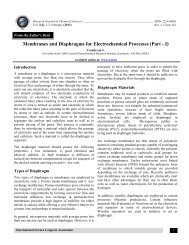A study of Thixotropic Alkyds based on Aram1de Chemistry - ISCA
A study of Thixotropic Alkyds based on Aram1de Chemistry - ISCA
A study of Thixotropic Alkyds based on Aram1de Chemistry - ISCA
You also want an ePaper? Increase the reach of your titles
YUMPU automatically turns print PDFs into web optimized ePapers that Google loves.
Research Journal <str<strong>on</strong>g>of</str<strong>on</strong>g> Chemical Sciences Vol. 1 (1) April (2011)<br />
Res.J.Chem.Sci.<br />
A STUDY OF THIXOTROPIC ALKYDS BASED ON "ARAM1DE<br />
CHEMISTRY"<br />
Jain Anamika<br />
Dept. <str<strong>on</strong>g>of</str<strong>on</strong>g> <strong>Chemistry</strong>, Govt. Girls P.G. College, Indore (MP),INDIA<br />
Available <strong>on</strong>line at: www.isca.in<br />
(Received 26 th March 2011, revised 28 th March 2011, accepted 5 th April 2011)<br />
Abstract<br />
Polyamides are reacted with alkyd resins to give thixotropic (n<strong>on</strong>drip) c<strong>on</strong>sistency. The Existing<br />
thixotropic technology <str<strong>on</strong>g>of</str<strong>on</strong>g>ten fails due to too weak structures. Also paints <str<strong>on</strong>g>based</str<strong>on</strong>g> <strong>on</strong> higher solid systems<br />
are more sensitive to tinting systems <str<strong>on</strong>g>based</str<strong>on</strong>g> <strong>on</strong> water, surfactants & other solvents, the thixotropic<br />
structure is hence not stable any more, also they lose their structure forming ability at temperatures<br />
above 45° C. This is due to poor associati<strong>on</strong> capability <str<strong>on</strong>g>of</str<strong>on</strong>g> H-b<strong>on</strong>ding network <str<strong>on</strong>g>of</str<strong>on</strong>g> polyamide <str<strong>on</strong>g>based</str<strong>on</strong>g><br />
modifiers.<br />
So to get the desired rheological properties, if stabilizers are added in the final paint formulati<strong>on</strong>, such<br />
paints could also become sensitive to changes in weather c<strong>on</strong>diti<strong>on</strong>s and may not remain stable over a<br />
period <str<strong>on</strong>g>of</str<strong>on</strong>g> time. The answer to this problem is to incorporate the rheological properties into resin instead<br />
<str<strong>on</strong>g>of</str<strong>on</strong>g> paint formulati<strong>on</strong>. So there is a need for str<strong>on</strong>ger & more stable thixotropic structures. If a polymide<br />
resin <str<strong>on</strong>g>based</str<strong>on</strong>g> <strong>on</strong> aromatic amide moieties was reacted with a dimeric fatty acid, it could be used to<br />
develop alkyd resins which show superior gel forming properties. Thus a new family <str<strong>on</strong>g>of</str<strong>on</strong>g> thixotropic alkyd<br />
resins for decorative applicati<strong>on</strong>s has been developed.)<br />
Introducti<strong>on</strong><br />
Polyamide modified alkyd resins are exclusively<br />
used in air drying decorative paints. They are used as<br />
blends with the unmodified alkyds or urethane<br />
modified alkyds to produce the thixotropic<br />
decorative paints.<br />
In the growing market for higher solid systems for<br />
decorative paints, reducti<strong>on</strong> in the amount <str<strong>on</strong>g>of</str<strong>on</strong>g> solvent<br />
while keeping paint performance <strong>on</strong> the higher level<br />
is the main goal.<br />
To get HS paints, alkyds resins with lower molecular<br />
weight, l<strong>on</strong>ger oil length should be designed, A<br />
combinati<strong>on</strong> <str<strong>on</strong>g>of</str<strong>on</strong>g> thixotropic resins & rheology<br />
modifiers such as Bent<strong>on</strong>es, Clays, aerosil or<br />
hydrogenated castor oils & waxes are used to get the<br />
right flow-sag balance, resulting in a stepwise<br />
formulati<strong>on</strong> <str<strong>on</strong>g>of</str<strong>on</strong>g> a complex paint.<br />
The incorporati<strong>on</strong> <str<strong>on</strong>g>of</str<strong>on</strong>g> proper rheological properties<br />
into the resins is must to get the stable thixotropic<br />
structure. The 3 basic building blocks causing<br />
thixotropy are the amide, the urethane & the urea<br />
group.<br />
A new family <str<strong>on</strong>g>based</str<strong>on</strong>g> <strong>on</strong> aramide chemistry exhibits a<br />
number <str<strong>on</strong>g>of</str<strong>on</strong>g> important features, which makes it<br />
suitable for use in high solid & high gloss decorative<br />
paints & stain applicati<strong>on</strong>s. Such a paint shows<br />
superior properties when compared to traditi<strong>on</strong>al<br />
polyamide <str<strong>on</strong>g>based</str<strong>on</strong>g> types or those <str<strong>on</strong>g>based</str<strong>on</strong>g> <strong>on</strong> urethane or<br />
urea chemistry.<br />
60
Research Journal <str<strong>on</strong>g>of</str<strong>on</strong>g> Chemical Sciences Vol. 1 (1) April (2011)<br />
Res.J.Chem.Sci.<br />
Objective: To <str<strong>on</strong>g>study</str<strong>on</strong>g> thixotropic alkyds <str<strong>on</strong>g>based</str<strong>on</strong>g> <strong>on</strong><br />
"Aramide <strong>Chemistry</strong>”. To find out the typical<br />
physical properties <str<strong>on</strong>g>of</str<strong>on</strong>g> different polyamide <str<strong>on</strong>g>based</str<strong>on</strong>g> <strong>on</strong><br />
thixotropic alkyd resins.<br />
Material and Methods<br />
Table-1: Formulati<strong>on</strong>s for thixotropic alkyd<br />
Soybean oil 29.45%<br />
Pentaerythritol 6.43%<br />
Phthalic anhydride 16.94%<br />
Fumaric acid 0.19%<br />
Xylene 1.92%<br />
Resin 2.30%<br />
White Spirit (Diluent) 42.77%<br />
Lithium Hydroxide 0.008%<br />
Process: Its manufacture involves:<br />
Alcoholysis: Soybean oil & pentaerythritol are<br />
alcoholysed at 245°C using lithium hydroxide as<br />
alcoholysis catalyst. Once a tolerance <str<strong>on</strong>g>of</str<strong>on</strong>g> <strong>on</strong>e part<br />
sample to 3 parts methanol (at 25°C) is obtained, the<br />
reactants are cooled to below 180°C & phthalic<br />
anhydride, fumaric acid, xylene are added.<br />
Polyc<strong>on</strong>densati<strong>on</strong> : Reacti<strong>on</strong> is carried out at<br />
260°C, <strong>on</strong>ce an acid value <str<strong>on</strong>g>of</str<strong>on</strong>g> 16mg KOH/ gm has<br />
been achieved, xylene is removed & esterificati<strong>on</strong> is<br />
c<strong>on</strong>tinued using a fusi<strong>on</strong> process until an acid value<br />
below 12 mg KOH/gm & viscosity <str<strong>on</strong>g>of</str<strong>on</strong>g> 20-25 poise at<br />
25°C is achieved..<br />
Polyamide Reacti<strong>on</strong>: The reactants are cooled to<br />
210°C & resin is added. The reactor is held at 210°C,<br />
while the reacti<strong>on</strong> between alkyd & resin occurs.<br />
The course <str<strong>on</strong>g>of</str<strong>on</strong>g> reacti<strong>on</strong> is studied by determinati<strong>on</strong> <str<strong>on</strong>g>of</str<strong>on</strong>g><br />
clarity <str<strong>on</strong>g>of</str<strong>on</strong>g> a 10% soluti<strong>on</strong> in white spirit. When the<br />
resin sample is completely' clear, the reactants are<br />
cooled & diluted with white spirit. By taking 5<br />
different thixotropic alkyds, Theological<br />
measurements were made in the white spirit. They<br />
all have a gel c<strong>on</strong>centrati<strong>on</strong> <str<strong>on</strong>g>of</str<strong>on</strong>g> 25%.<br />
Although the slope <str<strong>on</strong>g>of</str<strong>on</strong>g> graphs is equal showing equal<br />
recovery speed, the aramide <str<strong>on</strong>g>based</str<strong>on</strong>g> thixotropic alkyd<br />
appears more resistant to white spirit compared to<br />
polyamide, urea or urethane technology.<br />
The dependence <str<strong>on</strong>g>of</str<strong>on</strong>g> temperature: The aramide<br />
<str<strong>on</strong>g>based</str<strong>on</strong>g> thixotropic alkyd shows a much str<strong>on</strong>ger<br />
resistance against higher temperature. Polyamide<br />
loses its structure completely at higher temperature<br />
(above 45°C). The urea curve however, starting with<br />
low G' value at room temperature shows an<br />
increasing structure at elevated temperature, but it<br />
leads to handling problems in industrial use.<br />
Result and Discussi<strong>on</strong><br />
The rigid aromatic molecule has less freedom <str<strong>on</strong>g>of</str<strong>on</strong>g><br />
torsi<strong>on</strong> in aramide complex with respect to amide<br />
b<strong>on</strong>ds. Hydrogen b<strong>on</strong>ds in aromatic ring are<br />
stabilised by the mesomeric effects. When<br />
temperature is increased from 0°K to 300°K, H-b<strong>on</strong>d<br />
bridges in aramide complex remain intact while in<br />
Butane diamide complex, molecule loses its structure<br />
<strong>on</strong> <strong>on</strong>e side <str<strong>on</strong>g>of</str<strong>on</strong>g> the complex by increasing<br />
temperature. Hence due to lack <str<strong>on</strong>g>of</str<strong>on</strong>g> effective H-b<strong>on</strong>d<br />
bridging & stabilizing groups aliphatic amide<br />
polymers lose their structure. So aramide <str<strong>on</strong>g>based</str<strong>on</strong>g> resin<br />
has the str<strong>on</strong>gest ability due to efficient H-bridging.<br />
C<strong>on</strong>clusi<strong>on</strong><br />
The new thixotropic resin family has str<strong>on</strong>g<br />
stabilising properties in polar solvents particularly at<br />
higher temperature compared to other well known<br />
systems. They are easy to handle & can be used to<br />
replace actual traditi<strong>on</strong>al resin mixtures. This resin<br />
also stabilises pigment pastes. The combinati<strong>on</strong> <str<strong>on</strong>g>of</str<strong>on</strong>g><br />
str<strong>on</strong>g associati<strong>on</strong> forces by hydrogen attracti<strong>on</strong> &<br />
low [viscosity makes it possible to use this type <str<strong>on</strong>g>of</str<strong>on</strong>g><br />
thixotropic resin in high ijoss paint systems. The<br />
paint manufacturing becomes easier, more accurate<br />
& more Ec<strong>on</strong>omical.<br />
References<br />
1. Bridle, Pitture Vernici, 63 (2), (1987)<br />
2. Nae H. N., Am. Paint and coat, J. Jan. (1993)<br />
3. Homer D., A. Wickers, 4 th Asia - Pacific<br />
C<strong>on</strong>f. paper 26, Hoi K<strong>on</strong>g (1994)<br />
61
Research Journal <str<strong>on</strong>g>of</str<strong>on</strong>g> Chemical Sciences Vol. 1 (1) April (2011)<br />
Res.J.Chem.Sci.<br />
4. Dent B.J. and Bernlmaier R., Am. Paint J.<br />
76(26), (1991)<br />
5. Rees S., Pol. Paints, Coirs J., 185, (1995)<br />
6. Newt<strong>on</strong> L., Paint and Resins, (1982)<br />
7. Pauling L., J. Amer. Chem. Soc., (1947)<br />
8. Aerts J. and King G. S. D., Bull. Chim. Belg.,<br />
106, (1997)<br />
Table-2: Some typical physical properties <str<strong>on</strong>g>of</str<strong>on</strong>g> different polyamide <str<strong>on</strong>g>based</str<strong>on</strong>g> thixotropic alkyd resins<br />
Resin<br />
Thermos<br />
Tabel><br />
50 0 C<br />
Polar<br />
Solvent<br />
Resistance<br />
For High<br />
Solvent<br />
High gloss<br />
Handling at<br />
70 0 C<br />
Handle at<br />
20 0 C<br />
Polyamide No No No No Yes Yes<br />
Polyurea Yes Yes Yes Yes No No<br />
Polyuretrhane Yes Yes Yes Yes Yes No<br />
Polyaramide Yes Yes Yes Yes Yes Yes<br />
62



